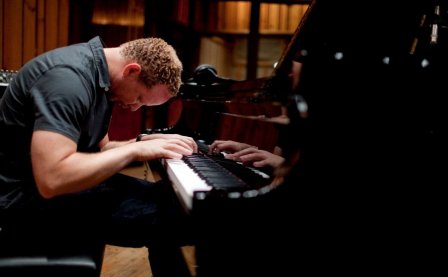There’s often a presumed interrelation between DIY scenes, academia, and even the world of institutional art personified by places such as NYC’s MoMA PS1, in the sense that social and artistic theory has long provided models and inspiration for those outré musical art forms and that cultural institutions have long taken to draping their positions of culture and economic power with the authenticity and radical energy of sounds and images derived from the DIY. It’s clearly a mutually productive endeavor, but what NYC theory-heavy arts mag Avant’s pyschoacoustic round-table-round-robin at ALLGOLD — a venue adjacent to and with definite but unclear associations to PS1 — brought to light was perhaps how tenuous and tense these associations are, despite mutually requiring one another.
With a full day of speakers and performances centered around drawing out pyschoaucoustics as a fraught transitory process from the neurological to linguistic, the event placed a wide variety of approaches in close proximity to one another — in addition to composer/theorists such as Ron Kuivila, Avant also invited guests such as Suzanne Dikker, a neuroscience who has developed a brain scan machine that models and projects the degree of neurological synchronicity between them on luminous orbs. It was this emphasis on hard sciences along side soft and artistic investigations that set this event apart — organizer and Avant editor Sam Hart is a neuroscientist and artist himself — and it was perhaps this strangely rare direct injection of hard sciences into the artistic model that pushed a sense of arts practices in terms of their location between academic and (extra-)institutional models.
This writer unfortunately missed the first part of the day due to that most extra-institutional and compelling model of all — being broke and needing to earn some cash — but the event’s last few hours seemed a decent model of what came prior, with the event divided into two stages, a darkened backroom hosting most of the musical performances and a bright-lit area hosting talks. I arrived to an an ultra-minimalist synth and amplified metronome piece by Seth Cluett, followed by Dikker’s talk and another traipse into the backroom for C. Lavender’s queasy and inconsistent meditative drone.
What was interesting was the degree to which dialogue seemed besides the point, even when speakers directly engaged with previous performances. The round-robin setting emphasized divisions over smoothness, with performances deviating from and unsettling the theoretical discussions prior — in this case, Lavender’s drone set echoed concepts of rhythmic anticipation models mentioned in Dikker’s talk, but carried with it swirls of affect tied to her specific production decisions, the purity of the original concepts breaking down in light of a music that evaded its theoretical frame. Here, the possibility of works to “fail” in the sense of overflowing or under-fulfilling the theoretic ground they have been tasked to embody acts as a safety valve, allowing currents of investigation to spill out and over into new models and areas, avoiding the abject summation that stands at the endpoint of many works that attempt to cross from one mode on inquiry to another under strict terms. In this light, I was particularly disappointed to have missed a talk between A.K. Burns and Jules Gimbrone on queer sound, what with the destabilizing and overflowing tendencies built into queer analysis from the beginning.
It was strange, then, when Ron Kuivila emphasized this crucial element of failure in works which aim toward research or experimentation in light of a piece that took its own place in an artistic/theoretic firmament as its basis, presenting a reworking of a Robert Ashley piece that folded layers of citation, temporality, and incommunicability into a work that seemed too easily summed up by its theoretical laying out, with his talk preceding it rendering the work itself — a Supercollider-manipulated vocal reading of a rewritten text that lists famous folks compulsively — relatively besides-the-point. (It also reminded me that I can’t stand Ashley for exactly this reason.)
At the same time, however, the failure of the piece’s built-in failure perhaps pointed to the relevance and necessity of an event like this in the first place — as a staging ground with an added vector of physical proximity upon which the fraught battles between cultural and research modes of production can be played out as a performance unto themselves. Hegemony hovers in the wings of all institutional productive processes, the DIY included, but in their liminal spaces new trajectories lurk.
More about: A.K. Burns, C. Lavender, Josh Millrod, Jules Gimbrone, Ron Kuivila, Seth Cluett, Sophie Landres, Suzanne Dikker



